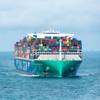MAN B&W Diesel A/S has been awarded the contract to carry out a large re-engining job on the car and passenger ferry Banasa. This is the third job of this scale to be carried out by the MAN B&W engine specialists at the company's own Service Center Denmark in Frederikshavn.
Earlier similar jobs included the Princess of Scandinavia (finished March 2000) and the re-engining/overhaul of four Olympic Countess main engines (finished spring 2001).
The common de-nominator is ferries or passenger vessels in the 20+ years age - where hull and accommodation has sufficient potential and where the machinery packages have to be brought up-to-date.
The ferry, owned and operated by Comarit (Compagnie Maritime Marocko-Norvegienne S.A. Tanger, Morocco) since 1996, serves the Mediterranean shuttle route between Agleciras, Spain and Tanger, Morocco.
Special circumstances with the Banasa mean that the job is performed in two steps. Due to the present condition of the existing 28-year old B&W 6S50HU main engines, a crankshaft has been replaced in one engine. This repair and replacement job was finished during June, whereas the removal of the damaged crankshaft and line boring of the engine block was performed in April by Service Center Denmark engineers on site. After completion, the vessel has maintained its summer season shuttle service with three daily roundtrips between Algeciras and Tanger until this autumn.
The Banasa is scheduled to arrive in Frederikshavn on November 10, 2003 and will, according to the re-engining contract, depart in March 2004. Step Two starts with the removal of the existing engines - and finish with the final installation of four new MAN B&W L27/38 engines.
New main engines
The new eight cylinder L27/38 engines are each rated 2,720 kW (3,700 bhp) at 800 rpm. This makes a new total main engine output for propulsion of 14,800 bhp - chosen for today's service speed of around 18 knots. Like the existing engines, the new engines are to be arranged in a twin-screw twin-in/single-out configuration and fitted to the existing Renk gears via new step-down gearboxes with a ratio of 800:450 rpm. The engines will be seated resiliently on new foundations. With regard to controls, the engines are to be interfaced with the vessel's original remote control systems for CP Propellers and the ship's alarm system.
Sponsored Content
Innovative Hull Maintenance: Profitable & Green

Subscribe for
Maritime Reporter E-News
Maritime Reporter E-News is the maritime industry's largest circulation and most authoritative ENews Service, delivered to your Email five times per week












